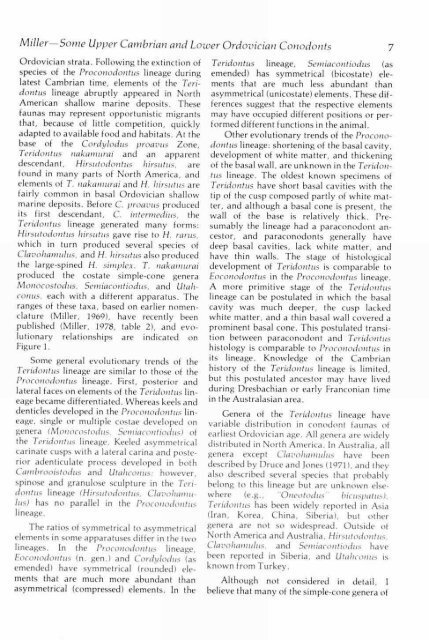View - KU ScholarWorks - University of Kansas
View - KU ScholarWorks - University of Kansas
View - KU ScholarWorks - University of Kansas
You also want an ePaper? Increase the reach of your titles
YUMPU automatically turns print PDFs into web optimized ePapers that Google loves.
Miller—Some Upper Cambrian and Lower Ordovician Conodonts 7<br />
Ordovician strata. Following the extinction <strong>of</strong><br />
species <strong>of</strong> the Procorlociontiis lineage during<br />
latest Cambrian time, elements <strong>of</strong> the Teridontus<br />
lineage abruptly appeared in North<br />
American shallow marine deposits. These<br />
faunas may represent opportunistic migrants<br />
that, because <strong>of</strong> little competition, quickly<br />
adapted to available food and habitats. At the<br />
base <strong>of</strong> the Cordylodus proavus Zone,<br />
Teridontus nakanutrai and an apparent<br />
descendant, Hirsutodontus birstitus, are<br />
found in many parts <strong>of</strong> North America, and<br />
elements <strong>of</strong> T. nakattutrai and H. hirsittus are<br />
fairly common in basal Ordovician shallow<br />
marine deposits. Before C. proavus produced<br />
its first descendant, C. intermedius, the<br />
Teridontus lineage generated many forms:<br />
Hirsutodontus hirstitus gave rise to H. rarus,<br />
which in turn produced several species <strong>of</strong><br />
C./two/up/in/us, and H. hirsittus also produced<br />
the large -spined H. simplex. T. nakatnurai<br />
produced the costa te simple -cone genera<br />
Monocostodus, Setniacontiodus, and Utahcorms,<br />
each with a different apparatus. The<br />
ranges <strong>of</strong> these taxa, based on earlier nomenclature<br />
(Miller, 1969), have recently been<br />
published (Miller, 1978, table 2), and evolutionary<br />
relationships are indicated on<br />
Figure 1.<br />
Some general evolutionary trends <strong>of</strong> the<br />
Teridontus lineage are similar to those <strong>of</strong> the<br />
Proconotiontus lineage. First, posterior and<br />
lateral faces on elements <strong>of</strong> the Teridontus lineage<br />
became differentiated. Whereas keels and<br />
denticles developed in the Proconodontus lineage,<br />
single or multiple costae developed on<br />
genera (Monocostodus, Setniacontiodus) <strong>of</strong><br />
the Teridontus lineage. Keeled asymmetrical<br />
carinate cusps with a lateral caria and posterior<br />
adenticulate process developed in both<br />
Cambrooistodus and Wain-onus; however,<br />
spinose and granulose sculpture in the Teri-<br />
&tutus lineage (Hirsutodontus, Clavoltanutlus)<br />
has no parallel in the Prot-or/odor/his<br />
lineage.<br />
The ratios <strong>of</strong> symmetrical to asymmetrical<br />
elements in some apparatuses differ in the two<br />
lineages. In the Procotiodontus lineage,<br />
Eocotiodontus (n. gen.) and Cordylodus (as<br />
emended) have symmetrical (rounded) elements<br />
that are much more abundant than<br />
asymmetrical (compressed) elements. In the<br />
Teridontus lineage, Semiacontiodus (as<br />
emended) has symmetrical (bicostate) elements<br />
that are much less abundant than<br />
asymmetrical (unicostate) elements. These differences<br />
suggest that the respective elements<br />
may have occupied different positions or performed<br />
different functions in the animal.<br />
Other evolutionary trends <strong>of</strong> the Proconodontus<br />
lineage: shortening <strong>of</strong> the basal cavity,<br />
development <strong>of</strong> white matter, and thickening<br />
<strong>of</strong> the basal wall, are unknown in the Tcridontus<br />
lineage. The oldest known specimens <strong>of</strong><br />
Teridontus have short basal cavities with the<br />
tip <strong>of</strong> the cusp composed partly <strong>of</strong> white matter,<br />
and although a basal cone is present, the<br />
wall <strong>of</strong> the base is relatively thick. Presumably<br />
the lineage had a paraconodont ancestor,<br />
and paraconodonts generally have<br />
deep basal cavities, lack white matter, and<br />
have thin walls. The stage <strong>of</strong> histological<br />
development <strong>of</strong> Teridontus is comparable to<br />
Eocoriodotitus in the Procottodontus lineage.<br />
A more primitive stage <strong>of</strong> the Teridontus<br />
lineage can be postulated in which the basal<br />
cavity was much deeper, the cusp lacked<br />
white matter, and a thin basal wall covered a<br />
prominent basal cone. This postulated transition<br />
between paraconodont and Teridontus<br />
histology is comparable to Proconodontus in<br />
its lineage. Knowledge <strong>of</strong> the Cambrian<br />
history <strong>of</strong> the Teridontus lineage is limited,<br />
but this postulated ancestor may have lived<br />
during Dresbachian or early Franconian time<br />
in the Australasian area.<br />
Genera <strong>of</strong> the Teridontus lineage have<br />
variable distribution in conodont faunas <strong>of</strong><br />
earliest Ordovician age. All genera are widely<br />
distributed in North America. In Australia, all<br />
genera except Clavoltamulus have been<br />
described by Druce and Jones (1971), and they<br />
also described several species that probably<br />
belong to this lineage but are unknown elsewhere<br />
(e.g., -Otieotodus - biciispatus).<br />
Teridontus has been widely reported in Asia<br />
(Iran, Korea, China, Siberia), but other<br />
genera are not so widespread. Outside <strong>of</strong><br />
North America and Australia, Hirsutotiontus,<br />
Clavolumulus, and Setniacontiodus have<br />
been reported in Siberia, and Mal/cot:us is<br />
known from Turkey.<br />
Although not considered in detail, I<br />
believe that many <strong>of</strong> the simple-cone genera <strong>of</strong>
















